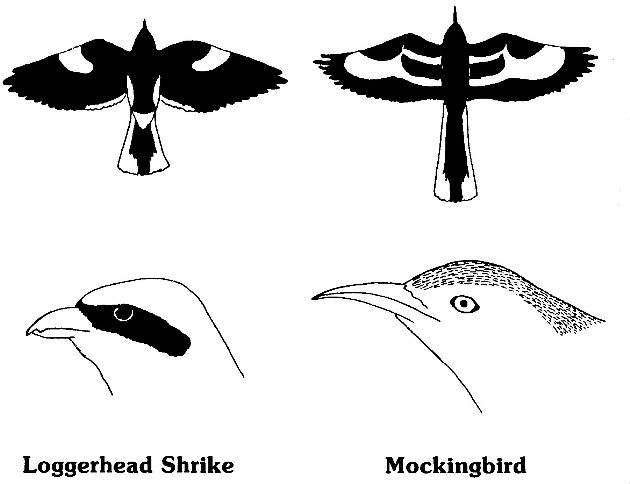The Loggerhead Shrike
a.k.a. The Butcherbird
Rusty Ryan
Conservation Chairperson of the South Mountain Chapter
of the National Audubon Society
 (Sept, 2010) Wanted: The breeding location of the Loggerhead Shrike. This bird is listed as Endangered in Pennsylvania and in Maryland.
(Sept, 2010) Wanted: The breeding location of the Loggerhead Shrike. This bird is listed as Endangered in Pennsylvania and in Maryland.
Description: The Loggerhead Shrike (shrike) is smaller than but comparable to in coloration to the mockingbirds black, grey and white. The most striking difference is the bill type, a hooked beak (like
birds of prey) and the distinct black facial mask (raccoon look) that runs through the eye.
Hunting Habits: The shrike is considered a songbird but our only songbird which is predatory like a hawk. The most unique habit for this bird and the reason for the nickname of butcherbird is the method
on how the shrike captures and kills its prey. The shrike is equipped with a hooked bill which is designed for tearing flesh however, the feet of shrikes are not comprised of strong talons and thus not designed to hold prey
during feeding. The shrike has evolved to utilize other objects to serve as feet. The shrike impales its prey on barbed wire or thorny plants such as locust and hawthorns. The impaling also provides the shrike with a means of
storing food. The hooked bill of the shrike is also designed for severing the spinal cord of the prey.
Habitat Requirements: The shrike prefers open grassy pastures that are well-grazed or mowed. Nearby scattered shrubs and trees and perching areas are a must. Roadside grassy ditches are also favored
places for hunting. The diet consists primarily of insects such as grasshoppers and beetles but small birds, small mammals, snakes, lizards and frogs will suffice when opportunity presents. Due to its primary diet of insects and
small mammals, the agricultural community has a friend not a foe. Nesting occurs in late April/early May.

Local Habitat and History: In 1992, the shrike was confirmed nesting in Freedom Township, Adams County. This nesting marked the first PA confirmed nesting of this once extirpated species in 55 years. The
shrike was confirmed nesting in Adams County between 1992 and 1999 with approximately 47 birds fledged. There has been no confirmed nesting of the shrike since 1999 however, individual; birds have been observed.
The Freedom Township Grasslands (open grasslands off of Pumping Station Road) is considered and Important Bird Area (IBA) by the Pennsylvania Audubon Society. Besides the Shrike, this unique ecosystem is
home to the Upland Sandpiper a PA Threatened listed species and two PA Endangered Species, the Dickcissel and Short-eared Owl (winter resident). This IBA also includes the PA Endangered Least Shrew (a mammal) as well as the
Bobolink, Eastern Meadowlark, Grasshopper Sparrow, Savanna Sparrow and Northern Harrier.
Reasons for decline: While the habitat appears to be present in this area, studies have shown that the following factors have led to the decline of this bird in the mid-atlantic region: loss of suitable
habitat (due to development and changes in agriculture), pesticide use and collisions with vehicles (due to hunting habits along roadsides).
What has been done locally to help the shrike: The National Park Service (NPS) here at the Gettysburg National Military Park have done some habitat enhancement work on a parcel of property near the
historic breeding sites but so far no luck. That work consisted of planting red cedars and hawthorns. With the NPS present management plan of removing forested acreage and restore the battlefield to 1860ís condition, this new
grassland habitat could potentially prove to be favorable to the shrike. Throw in some plantings of preferred shrubs and the recipe for success gets better. Now if only we could minimize mortality due to collisions with
vehicles. I suppose the NPS could impose restrictions on certain roads seasonally but that season would coincide with the tourist season and that would most likely cause friction. I for one believe the creation of this grassland
habitat nearby the 1990ís breeding locations will be great for the butcherbird. I also believe the open grasslands of southern Liberty Township (properties off of Tract Road) has potential.
As for the privately owned lands, education is the key. This is where the local Audubon Society and other such groups can make a difference. For those who have the right habitat, the outreach may be as
simple as notification and some property management tips. For the property owners who wish to enhance their property for the shrike and other grassland birds the task may be a bit more complex. Thankfully, the PA Game Commission
does provide individual property management for wildlife (www.pgc.state.pa.us).
- http://pa.audubon.org/iba/
- http://centralmdaudubon.org/index.htm
- http://pubs.cas.psu.edu/freepubs/pdfs/UH158.pdf
- http://www.pbase.com/rcm1840/loggerheadshrike
So when traveling through the beautiful rural countrysideís of Adams and Frederick County next May, keep a close eye out for the butcherbird perched overhead. Even if you donít see the bird but instead
you can locate some of their victims impaled, the chances are good that the shrike may be close by.
To report sightings of possible breeding shrikes, contact the PA Game Commission or the Maryland Department of Natural Resources. You may also wish to contact the local Audubon Society or utilize the web
site: www.eBird.org
I would like to thank Deb Siefken of the South Mountain Chapter of Audubon, Christy Hemler and nature photographer Bob Moul for their contributions to this article.
Read other articles by Rusty Ryan